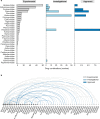Seven classes of antiviral agents
- PMID: 36436108
- PMCID: PMC9701656
- DOI: 10.1007/s00018-022-04635-1
Seven classes of antiviral agents
Abstract
The viral epidemics and pandemics have stimulated the development of known and the discovery of novel antiviral agents. About a hundred mono- and combination antiviral drugs have been already approved, whereas thousands are in development. Here, we briefly reviewed 7 classes of antiviral agents: neutralizing antibodies, neutralizing recombinant soluble human receptors, antiviral CRISPR/Cas systems, interferons, antiviral peptides, antiviral nucleic acid polymers, and antiviral small molecules. Interferons and some small molecules alone or in combinations possess broad-spectrum antiviral activity, which could be beneficial for treatment of emerging and re-emerging viral infections.
Keywords: Antiviral; Antiviral drug combination; Broad-spectrum antiviral; Virus; Virus–host interaction.
© 2022. The Author(s).
Conflict of interest statement
The authors declare no conflict of interest.
Figures




Similar articles
-
Seeking innovative concepts in development of antiviral drug combinations.Antiviral Res. 2025 Feb;234:106079. doi: 10.1016/j.antiviral.2025.106079. Epub 2025 Jan 9. Antiviral Res. 2025. PMID: 39798882 Review.
-
Trends and strategies to combat viral infections: A review on FDA approved antiviral drugs.Int J Biol Macromol. 2021 Mar 1;172:524-541. doi: 10.1016/j.ijbiomac.2021.01.076. Epub 2021 Jan 14. Int J Biol Macromol. 2021. PMID: 33454328 Free PMC article. Review.
-
Discovery and development of safe-in-man broad-spectrum antiviral agents.Int J Infect Dis. 2020 Apr;93:268-276. doi: 10.1016/j.ijid.2020.02.018. Epub 2020 Feb 17. Int J Infect Dis. 2020. PMID: 32081774 Free PMC article. Review.
-
Broad-Spectrum Antiviral Entry Inhibition by Interfacially Active Peptides.J Virol. 2020 Nov 9;94(23):e01682-20. doi: 10.1128/JVI.01682-20. Print 2020 Nov 9. J Virol. 2020. PMID: 32907984 Free PMC article.
-
Drug Repurposing for Viral Infectious Diseases: How Far Are We?Trends Microbiol. 2018 Oct;26(10):865-876. doi: 10.1016/j.tim.2018.04.004. Epub 2018 May 11. Trends Microbiol. 2018. PMID: 29759926 Free PMC article. Review.
Cited by
-
Tyrosine Kinase Inhibitors Target B Lymphocytes.Biomolecules. 2023 Feb 25;13(3):438. doi: 10.3390/biom13030438. Biomolecules. 2023. PMID: 36979373 Free PMC article.
-
Function and Mechanism of Antiviral Wasp Venom Peptide Protopolybia-MP III and Its Derivatives against HSV-1.Toxins (Basel). 2024 Mar 4;16(3):132. doi: 10.3390/toxins16030132. Toxins (Basel). 2024. PMID: 38535798 Free PMC article.
-
Practical Recommendations in the Treatment of Acute and Chronic Life-Threatening Infectious Diseases in Patients with Acute Hepatic Porphyria.Metabolites. 2025 Feb 5;15(2):99. doi: 10.3390/metabo15020099. Metabolites. 2025. PMID: 39997724 Free PMC article. Review.
-
Organ-on-chip models for infectious disease research.Nat Microbiol. 2024 Apr;9(4):891-904. doi: 10.1038/s41564-024-01645-6. Epub 2024 Mar 25. Nat Microbiol. 2024. PMID: 38528150 Review.
-
Metabolism-associated protein network constructing and host-directed anti-influenza drug repurposing.Brief Bioinform. 2025 May 1;26(3):bbaf163. doi: 10.1093/bib/bbaf163. Brief Bioinform. 2025. PMID: 40315435 Free PMC article.
References
-
- Ianevski A, et al. DrugVirus.info 2.0: an integrative data portal for broad-spectrum antivirals (BSA) and BSA-containing drug combinations (BCCs) Nucleic Acids Res. 2022 doi: 10.1093/nar/gkac348. - DOI - PMC - PubMed
Publication types
MeSH terms
Substances
Grants and funding
LinkOut - more resources
Full Text Sources
Medical

